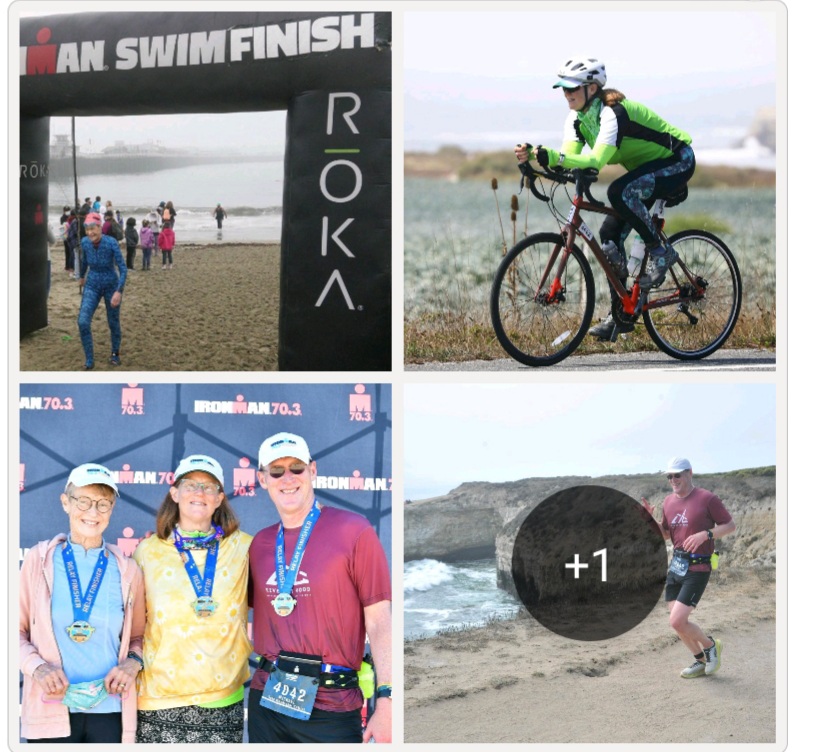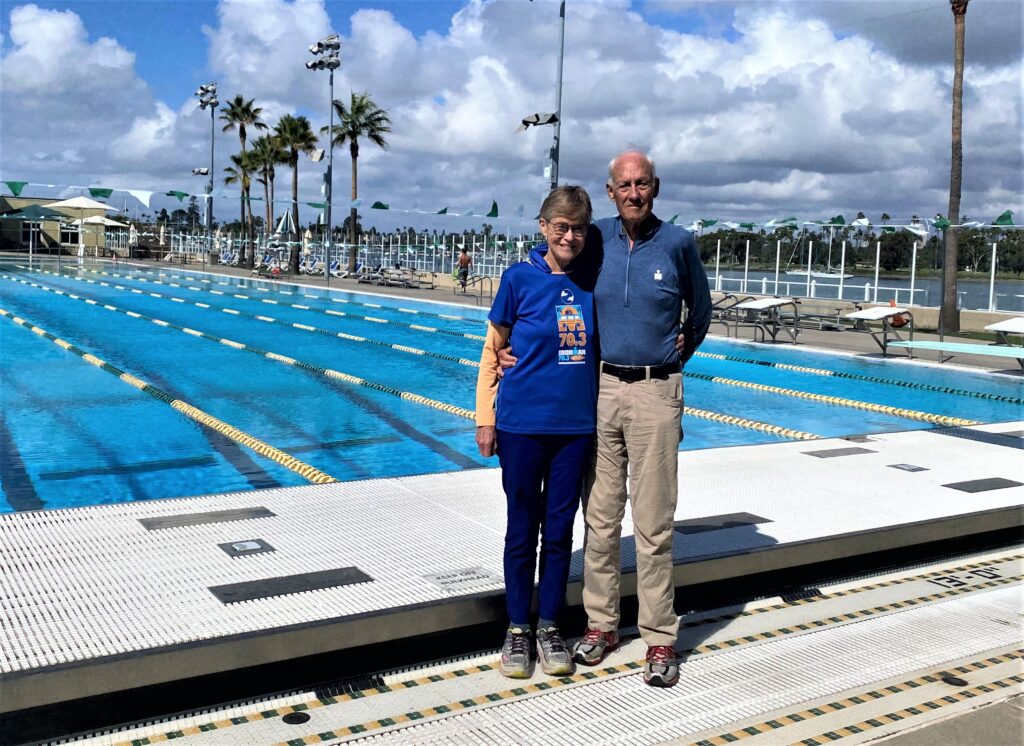
“Brag for the rest of your life” was the motto that John and Judy Collins envisioned for the finishers of the Iron Man Triathlon they created. The dynamic duo give partial credit to the former Coronado community pool, back in 1973, for getting them started with swimming, and then moving on to endurance sports. Even though he gets credit for masterminding the first event, John says it was really all Judy’s idea. The stories that have circulated for the last 43 years often contain myths that have been passed down as fact, but they tell a different version of how they created the original Hawaiian Iron Man Triathlon in 1978.
It took numerous things lining up to create the first Iron Man event, as Judy details it, giving former Aquatics Director Stan Antrim credit for pushing them to swim and gain endurance and become charter members of the Coronado Masters Association (CMA), and then good fortune when the Navy sent them to Hawaii. “Those were our best fitness years,” they fondly remember.
Having grown up in a military family, Judy MacGregor-Collins has a long-standing history with Coronado. She sporadically attended Coronado schools, CHS class of 1956, but moved around to different duty stations with her family through the years. She remembers always avoiding PE classes in school because she wasn’t good with hand-eye coordination in team sports, so that took down her grade point average. As a child, she remembers enjoying catching waves in the ocean and playing Marco Polo in the Navy pool but didn’t consider herself a real swimmer. John was born in New Mexico, but grew up in Texas, far from the ocean water he now loves. An aviation and nautical enthusiast, he is a pilot and a sailor.
They were married the same night that John was commissioned in 1959. John’s first duty station was here in Coronado as a Junior Officer on the USS Mullany. He later became a nuclear submariner, but was later transferred to engineering duty, after an asthma diagnosis. He earned degrees at MIT graduate school to become a Naval Engineer. While stationed at Mare Island Naval Shipyard, the family enjoyed outdoor activities such as biking and backpacking to Yosemite, and John became a private pilot. During that time, Judy went to UC Berkeley and earned a degree in Conservation of Natural Resources, attended UCB graduate school, and later subbed as a reading teacher and worked at the Coronado Library. She also served on various Governor’s Commissions in Hawaii, worked on Capitol Hill, and was a Public Relations Officer for the Smithsonian, among other jobs throughout her life.
While stationed in Coronado again in 1973, always one to be active, Judy seemed restless at night, so John suggested that she find something to do. Swimming classes at the community recreation pool were at the right time, so she signed up. The first night, she scanned the other swimmers dressed in what she considered professional gear and felt inadequate in her simple two-piece suit, so she turned around and went home. Since she had already paid, John encouraged her to go back and give it a try. Quickly, John noticed she was relaxed after swimming, so he got off the couch and joined too. That’s where they met Stan, who was an inspiring task master who converted his swim class into a competitive swim club, CMA. They were what Judy affectionately calls “adult onset recreational athletes.”
They made many friends in CMA, including Flo Squires and Bill Earley, and they still visit his commemorative plaque at the pool. CMA, which was still active until COVID hit, was a combination of former college swimmers and novice recreational swimmers, so Stan encouraged them to start running to strengthen their endurance. They joined a group who ran three miles around the golf course on Wednesday nights. “We were definitely not jocks,” laughs Judy.
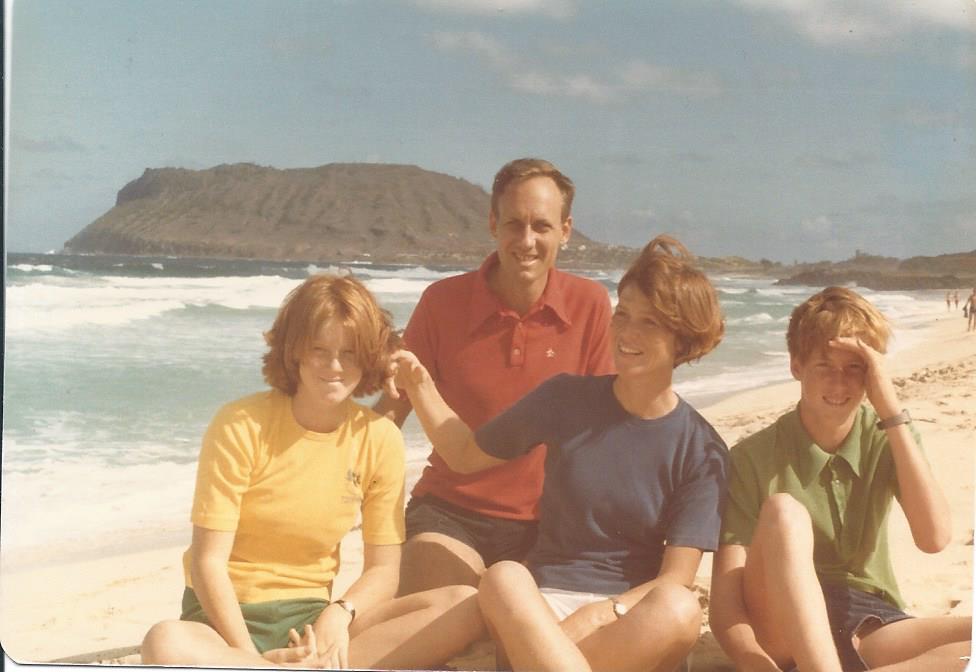
In 1974, Flo Squires invited CMA members to take part in a special event and Judy and John said yes. That is how the entire family ended up running in the San Diego Track Club’s Mission Bay Triathlon in 1974. John and Judy promoted an idea to Stan, and in 1975 the first Coronado Optimist Club Triathlon was held, which is the longest continuously running triathlon in the world. Having planted seeds in the fitness arena, both of their children swam in high school and college.
After John was transferred to Hawaii, they joined the Waikiki Swim Club and participated in the annual 2.4 mile Waikiki Rough Water Swim, even though they had previously only done a maximum of one mile in the cold ocean waters of Coronado and La Jolla. They also joined the Mid-Pacific Road Runners Club and ran in the Honolulu Marathon, learning a valuable lesson from the Marathon Clinic coach, “Train enough to find the pace where you could run forever.” It’s important to note that the 1970s were the peak of long distance events and challenge events, where the goal was to complete them, but not necessarily go for the fastest time, and this matched their philosophy of focusing more on endurance than speed. Another highlight came on Mother’s Day in 1977, when Judy was the first woman to swim island to island, Lanai to Maui, continuing her streak of breaking boundaries. John was in the support boat keeping an eye out for sharks.
Judy and John got assigned responsibility for a sprint run and swim event in 1977. That inspired Judy to create an alternate event they were more interested in for 1978, the first triathlon in Hawaii. They wanted to bring the sport of triathlon to Hawaii because Judy felt that the combination of three sports was more interesting. Her idea of adding the bike leg was to connect the swimming and running segments, which would be the Waikiki Roughwater Swim and the Honolulu Marathon. Bicyclist John suggested the annual O’ahu Bike Ride route, which they thought was 115 miles, not realizing it was conducted over two days, so they decided on 112 miles for the bike portion to make it fit between the two events. With a myriad of hurdles to overcome, they learned to adapt as the event approached.

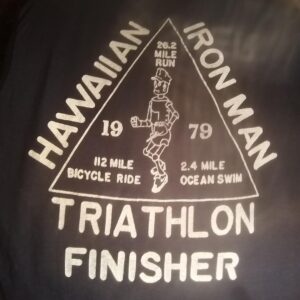
The first Hawaiian Iron Man Triathlon was held on February 18, 1978. The name “Iron Man” came from one of John’s shipyard coworker’s nicknames, known for his keep-going-forever pace. The $5 entry fee included bringing a t-shirt to their home to have the logo screen printed on and then having “finisher” added if they completed the event.
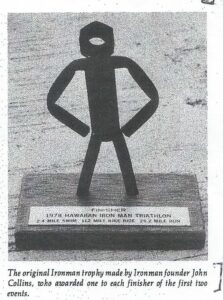
John also welded copper pipe trophies for everyone, but chuckles as he remembers his subpar welding skills. They loved the event, which Judy couldn’t participate in at the last minute, but John did, coming in ninth, with a finishing time of 17 hours and 3 seconds, which is now coincidentally the cut off time for today’s Ironman.
“We designed Ironman for regular people like us, not competitive athletes,” they comment. The second year, the event was almost cancelled due to weather. Fifty people expressed interest, but severe weather made them change from Saturday to Sunday and they again had 15 participants – their 16-year-old son Michael was the youngest. The event was featured in an eight-page-spread with photos in Sports Illustrated. ABC Sports called in 1979 to ask to film the 1980 Iron Man and John and Judy said yes.
They planned to retire in Hawaii and continue to host the event, but the Navy transferred them, so they gave their event information box to Hank at Nautilus Fitness to continue their beloved event. “We got the Ironman going, but it would have stayed a smaller scale under us,” said Judy. “We wanted ordinary athletes to always be able to compete and didn’t think of the entrepreneurial aspect of the sport, and we asked that the Collins family always be able to participate if they wanted to,” comments John.
After moving, they followed the progress of the Ironman through the Waikiki Swim Club newsletter and saw it was moved to the Big Island for additional space, and then in 1982 it was shifted to October, for better weather conditions. They credit Valerie Silk as one of the people who helped propel it to the iconic sporting event that it is today. Silk also changed “Iron Man” to Ironman (IM). It is now organized by the World Triathlon Corporation (WTC) and is widely considered the most difficult sporting event in the world.
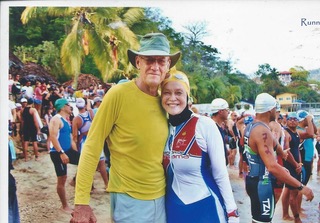
Of the thousands of articles and media coverage written about the birth of the Ironman Triathlon over the past four decades, they note that less than a dozen have the correct facts, and they would like people to know how it really came to be with all the stars lining up in Coronado and Hawaii. They were just two people who wanted to create a fun endurance event in which finishers could “brag for the rest of their life.” It didn’t stem from a SEAL challenge or any of the other stories that have been passed down. They were inducted into the Ironman Hall of Fame in 1998, and then the USA Triathlon Hall of Fame in 2014. They returned to various Hawaiian Ironman Triathlons through the years, discovering not much had changed from their original concept, except that the bike leg is much harder when done on the volcanic Big Island than it was on coastal O’ahu.

John retired as a Navy Captain after 30+ years, and they have continued to live an active lifestyle. They founded the Portobelo Extreme Triathlon in Panama, where they lived 50 percent of the time pre-COVID. They call it “the Hawaii you can drive to” and have made the 4400-mile trek three times in their trusty 1968 VW bus, which took them to the early Coronado swim events. They sailed their boat from Coronado to Panama, planning to sail to Europe, but felt at home and stayed.
Now, here full-time in Coronado during the pandemic, these octogenarians bike and jog/walk together and Judy still swims three days a week, and their favorite Coronado spot is naturally Central Beach. In fact, Judy just did a three-generation Ironman 70.3 relay with her daughter Kristin Galbreaith (CHS ’78) and granddaughter Siri Collins Kahn (CHS ’12), as Team MacGregor-Collins, and her son Michael (CHS ’80) and his son Iain also completed the event in Salem, Oregon in July. She also did another IM triathlon relay in September with her children in Santa Cruz. There is even a new professional Championship Triathlon in Slovakia, called the “Collins Cup,” honoring professional tri-athletes named in their honor. These two have definitely earned bragging rights!
To learn more about the rest of their story, check out their website at https://thiswastriathlon.org/.
